#do this is because of the negative amounts of worldbuilding we get around the nations :(( please tell me more than 7 heroes 7 nations and
Explore tagged Tumblr posts
Note
Bloodbag anon again. I’d like to apologize if I came across as rude or overbearing in my post. Didn’t mean for that, I got a lot of big feelings on the subject and afraid I may of over stepped my welcome.
I will agree though, we do have different idea’s as to how vampires feeding work. I’m one who generally prefers exploring the darker or more gritty side to stuff like vampirism/ lycanthropy/ and other similar fantasy conditions. Generally exploring that being a vampire or werewolf is an actual curse that has a deep negative impact on the characters life, not just being cool superpowers with minor side effects. But that’s just me, everyone is entitled to their own perspective and that’s what makes worldbuilding and storytelling with these creatures so fun in the first place!
On the brighter side, I’d like to hear what your concepts are for vampire feeding and dietary behavior? How do your vampires obtain their blood ethically and sustainably, and what’s the general attitudes around them?
Not at all, anon! Like I said, we just have different storytelling preferences. My job is very serious, so I tend to prefer my media and entertainment more lighthearted. In the only full "vampire adventure" urban fantasy I've ever written (well, am writing), which is based on the Netherlands, the existence of vampires is a poorly kept secret and there is a branch of the national blood bank service which offers vampires donated blood. Not all vampires want to make use of their services, however, in some cases because they don't believe the blood bank's promise not to keep records on their patients.
Other ways various vampires in my urban fantasy world feed themselves:
Regularly drinking from the same human(s) who they have bonded with by regularly exchanging blood. (Frowned upon by those who remember the days that these bonds were used to control people or that believe vampires should keep their existence a complete secret.)
Drinking animal blood, even though this blood is less potent than human blood and therefore diminishes the vampire's strength over time. (Frowned upon by those that argue you can get consent from a human, but not from an animal, and that small animals often die.)
Drinking very small amounts from consenting sexual partners and feeding them a little of their own blood to get them high and heal them up. (Frowned upon by those who feel that even if they consented to getting high and swapping fluids and had a great time, it's not exactly informed consent.)
Drinking from other vampires they're close with. (Generally accepted as shifting the problem rather than solving it, because it means the vampire being fed on must drink for two.)
Attacking people. (Frowned upon by the mortal and immortal community alike. Vampires that feed like this do not last long.)
But this is a world that is slowly transitioning from vampires existing in secrecy to them living out in the open, so it's a very specific setting. And it's based on the Netherlands which is a small, bureaucratic, densely populated welfare state in which vampires just don't stand much of a chance of hiding indefinitely :P
27 notes
·
View notes
Note
This is a really fantastic post. Having played… a lot of gacha games in my time, what I find really fascinating about Arknights is that the story and the gameplay are both built on such a solid foundation that they make it possible for the developers to create interesting gameplay scenarios, and to create interesting story scenarios.
Arknights is, at its core, a very good and very interesting game. The core mechanics are deep and well-thought out, which makes the gameplay resilient and adaptable to power creep, while also accommodating the addition of many new characters, who provide new tactical tools you can bring in your large group of units to each battle.
The core gameplay is also able to be flexible because it stands on its own. Think of it like this. In many gacha games, you have some characters who are interesting, but have deeply flawed kits, and that requires you to teambuild and play around their weaknesses to let them perform. They have negative synergy: they require other units with positive synergy to bring them up to par. Meanwhile you have some units with fundamentally well-designed kits, which can stand on their own and be fit into a variety of tactical situations, where you don’t have to think about making them work, they can just contribute to the team. Most gacha games are the former type: Arknights is the latter. It does not require design to address its weaknesses: merely to create new, interesting scenarios. That’s why we have IS, CC, SSS, Interlocking, etc.
And meanwhile, on the story end, they’re doing something similar. Strong, concrete rules for the world—not just a power system, but a political, social, economical, and geographic one. The world is sturdy enough to sustain investigation and time spent in its corners. As a storytelling space, it operates almost by the One Piece principle: there’s enough connective tissue, enough planning, that any random character or setting detail—something the characters have heard about in a vignette, a small aspect of a previous run of worldbuilding, something mentioned by a side-character—can and does support an entire side-story surrounding it. It gives you the impression, over time, that this is a huge world with an infinite amount of things to learn in it. It feels real.
And that, too, suits a gacha game, which will always be looking for new stories to tell, new characters to tell them about. Everyone is anchored in this world, has a history and a present and a future that is not so easily ignored. The characters don’t (can’t) just get up and leave the setting at a writer’s whim: they live there. They have roots. They’re real, too.
All of this together is why something like IS3 hits so hard. There is so much world to destroy. And that palpable loss, that narrowing of the expansive world to your squad steadily moving deeper and deeper into the waves, creates this sense of danger and claustrophobia. There’s so few people left that you’re inheriting the will of entire nations—Yan, Sargon, Victoria, even Ursus, whose fearsome Blades have already been overrun. They are the closest thing to an enemy nation, but at the end of the day, you’re all human, and the enemy is not.
And the gameplay is adaptable enough to tell this story as well. Struggling for resources in a roguelike scenario, scrounging together a small team of what survivors remain to continue challenging the sea. Yes, this is an Iberian event, and the Iberian and Aegrian operators and their tragic fates are involved, but so is everyone else, in the little details.
Whether it’s humble perfumer Lena, shining against the darkness, making a scent to remind operators of what the woods and nature once smelled like, to remind them what they’re fighting to avenge:

or whether it’s watching Carnelian, who I have trusted as a reliable pillar of my formations since the early days of my time with the game, who is defined by her strength and ferocity and who has a whole story of her own waiting for her, crumble like tissue paper in front of enemies because she’s been afflicted by a permanent illness that destroys her way of fighting, and realizing that her only remaining use is as a distraction.
IS3 is a demonstration of the unique kind of storytelling and gameplay, and the interface between them, that is possible thanks to the way Arknights is designed. I don’t think any other game can really achieve the same effect.
It’s a real demonstration of the power of solid fundamentals and disciplined design. I think the way Arknights operates is quite beautiful.
What are some of the greatest/most impressive feats of strength in Arknights’s story?
Taking the overall narrative and worldbuilding into account, I believe the most effective aspect of Arknights' narrative is that they managed to make Terra feel like a breathing, living world and setting instead of a vehicle for the point-of-view character to exist in and act upon. This is specially remarkable for a mobile gacha game, as settings in these tend to be exactly that sort of vehicle instead of world that give any hints of existing when outside the player's immediately vision. The way I like to think about it is, "if a tree fell somewhere in this setting while my intended point-of-view or self-insert character isn't there to see it, did it make a sound?". In pretty much every game of this sort that isn't Arknights, Girls' Frontline and SIGH Epic Seven (credit where it's due), the answer feels like a yes to me, whereas in every other, it feels like a no, if you know what I mean.
This is intrinsically tied to the cast of characters: It is an inevitability that games where a guiding principle is to release an immense number of characters throughout its lifetime will have characters that will never have any relevance whatsoever besides existing as a minor piece in the world, and Arknights is not immune to this. Even other works of a different base nature and with a much smaller casts will be victims to this: In Trails of Cold Steel, for example, you have a pretty big cast of playable characters, some of which are very well developed and have a lot of screentime and development, and others who are Gaius Worzel. However, this leads to two aspects of Arknights as a narrative and as a game telling a story and fleshing out a world that I appreciate:
The first is that those characters that do get used, are for the overwhelming majority fun and interesting to see and accompany throughout their narrative, and rarely for me, I include the usual point-of-view character in this, Doctor. I tend to have a pretty big dislike, if not disdain, for characters you're meant to self-insert into, I sincerely cannot stand them. Doctor definitely has a big of a self-insert nature to them, but there's also a lot of the Doctor that is actually pre-established, such as them being a weirdo, tending to be very effective but also causing troublesome aftermaths that others then have to clean up, and being particularly good at bonding with assassins and underworld types, among other things. More importantly, Doctor is not present in most side-stories. This is fantastic and leads to the second aspect I appreciate.
This second aspect is that the cast has legs to stand on without needing the protagonist or POV character. You'd think this is a problem mostly limited to gacha games due to their usually flimsy narratives and structures, right? Except, this is actually a huge problem in pretty much every corner of narrative art! I can think of countless comics, manga, cartoons, anime, light novels, novels, and much more, eastern and western, that just tend to have worlds and casts that center entirely around the protagonist, for the protagonist. Whether it be a US author writing out their post-apocalyptic hoarder fantasy or a Japanese author detailing the trials and tribulations of a relatable nobody that a myriad of girls want to have sex with, and even some other pieces of art perhaps not so comically easy to make fun of, it's a consistent aspect of them that the protagonist is the center of the universe, both in terms of events and what the rest of cast thinks about, talks about, and takes action upon. Obviously, this results, in my opinion, in weak worlds and weak casts that have no legs to stand on. I appreciate that even without Doctor around, Arknights does a good job of having protagonists of their own little stories in the side stories: Olivia Silence is a joy to follow when she takes the lead in a Rhine Lab story, Kroos has been one of my favorite characters to be able to experience events through with the Sui stories, Skadi and the Abyssal Hunters are exciting to watch in Abyssal Hunter stories, and the latest event as of the writing of this post filled me inspiration, seeing Reed star in a character piece that tells us more about someone so immensely reticent to open up. It's by having interesting world events occurring throughout Terra that don't have the input of Doctor, and thus lets us see more and more of this huge cast of characters taking the lead that I think is a fascinating experience for me as a reader that keeps things fresh. It's even allowed me to come to appreciate characters I initially didn't care about, such as Bagpipe and Magallan, and see, in most games of this nature, if I don't care about a character frame one, it's probably going to stay that way because, well, if I didn't care about what their limited assortment of pre-cooked lines had to sell me on, then I'm likely not going to care about that character likely not showing me a new aspect of themselves impactful enough to change my mind in an event they'll likely just be an accessory to.
It's upon this base that I think Arknights stays interesting and fresh: A solid foundation that I can agree with and that keeps things dynamic and interesting. Specific events and story beats that I think are interesting are a natural result of these baseline aspects, but it all traces back to the cradle, to these baseline aspects that facilitate those cool narratives in the first place.
343 notes
·
View notes
Text
Thoughts on Worldbuilding: Storytelling with Geography: Lunar Lakes
So I've been thinking about worldbuilding for awhile, and one of the things that I like about certain worlds is that they tell a story with their geography. I think Lunar Lakes is one of these worlds.
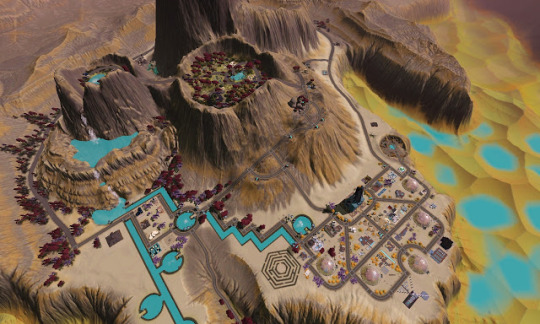
Image: An overview of Lunar Lakes from Sims 3
All Lunar Lake images will be from here
This is going to draw from James C. Scott's The Art of Not Being Governed and the concept of Zomia
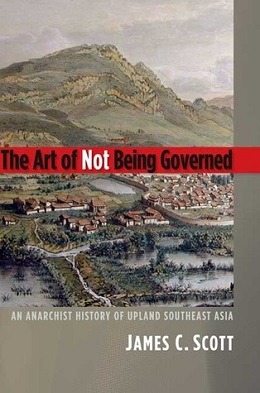
So one of the central concepts behind Zomia and The Art is the idea that not everybody wants to be a part of centralized governments or nation-states.
Traditionally, most academic fields have held that as societies centralize around agricultural centers that evolve into urban centers, they draw everybody to them through some kind of unexplained magnetism as they gradually expand. It's usually held that this is because the centralizing power of agriculture allows for population booms not supported by hunting-and-gathering. At least one philosopher <cough> Daniel Quinn <cough>1 this is a result of these populations controlling access to food. Not just surpluses of food, but access to food at all, forcing those within their borders to join the system or die.
This idea that agricultural societies are somehow fundamentally better. We see this reflected in different cultural evolution models (all of which are horribly racist but still manage to hang on in weird places, particularly developmental models). As such, the shift from hunting-and-gathering to sedentary agriculture tends to be heralded as a good thing in most history text books and is pretty much always seen as a step towards "modernization.2" But what if you don't want that? What if you have zero interest in joining the agricultural community and implied state control?3 What options do you have then?
You, then, may be interested in Zomia or one of the other extra-territorial spaces that function similarly.

Image: A village in the mountains
So what is Zomia? Zomia encompasses a large territory that ranges across Southeast Asia up into Tibet. Its primary defining feature is its rugged terrain and various populations that have no interest in different state-sponsored "civilizing" projects. While different agricultural centers expand outward to fill the lowland regions seeking to bully those they encounter along the way into joining, various people along the way say "f*ck it" and go up into the mountains. Why? Because the rugged terrain makes it harder for their valley-based neighbors to control them while providing plenty of hiding places push back against their expansion.
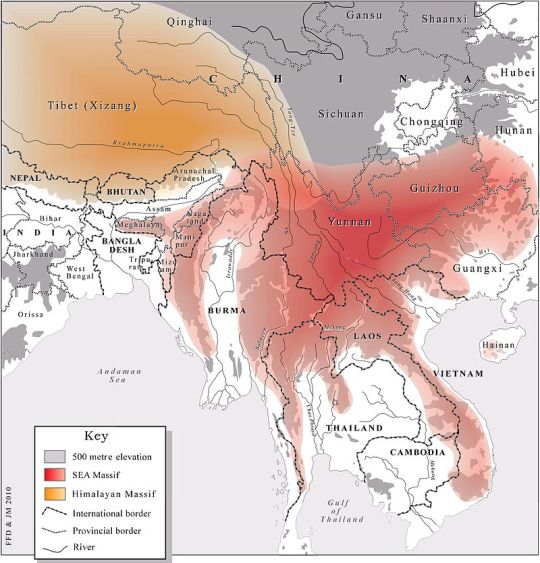
Image: A map of the Zomia area highlighting the Southeast Asian and Himalayan Massifs, areas encompassing the geography of Zomia itself.
Agriculture tends to lock people into place and makes them easier to control, therefore nation-states interested in keeping track of large populations have a vested interest in convincing people to farm. Buggering off into the mountains offsets this. Agriculture isn't necessarily harder in these mountainous areas4, but you do have different crops as a result of altitudinal zonation and a fair amount of people choose to engage in animal husbandry instead because the high altitudes impact calorie consumption as your body spends more energy keeping you warm.
This impacts cultures in these regions as well. People may choose to define themselves in opposition to the lowland culture they are avoiding. They may hybridize with cultures already in the mountains, create new languages, or define themselves by the fact they are there for political or semi-political reasons and expressly avoiding the control of an outside party, even if that outside party is the nation-state they are legally considered a part of. There is also a tendency of these cultures to discard literacy for orality, in part because orality is easier to carry around and in part because it marks them as Other compared to their lowland counterparts. It also gives you a since of control over your culture itself, as orality can't be shared unless you want it to whereas almost anyone can learn a writing system and open a book.
So what's this got to do with Lunar Lakes? Let's look at LL more closely, shall we?
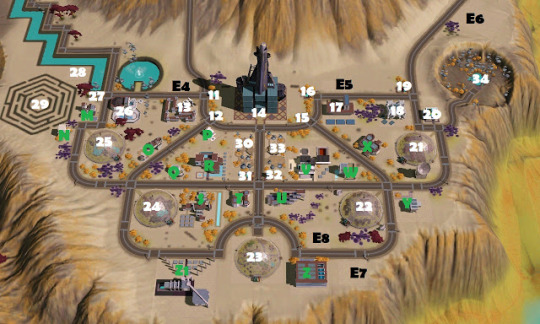
Image: The downtown region from Lunar Lakes
The most densely developed part of Lunar Lakes is easily this "downtown" district in the lowlands region. This area contains most of the community lots for the world, and, most tellingly, City Hall and the Perigee, which we're told in the original blurb brought the (human) sims to Lunar Lakes to begin with.
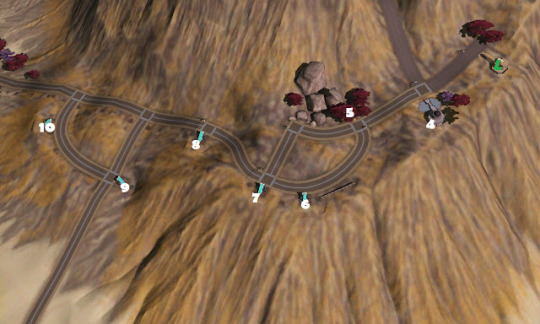
Image: The Rim
There is a little bleed over of rabbitholes from the city center onto the Rim, a slightly elevated area just above it, but these are no where near as "mountainous" as the craters we'll get to in a minute.
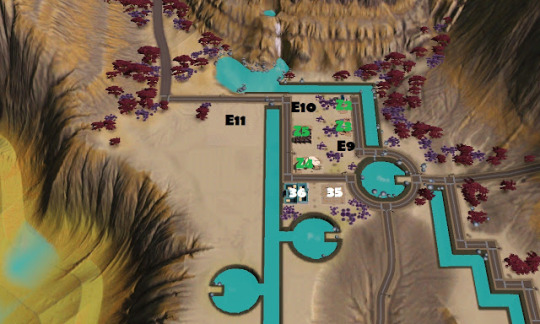
Image: The Canals
Another defining feature of the lowland central area are these canals. As these canals do not extend to a beach or other waterway, they can't be for trade, thereby lending themselves to the idea that they are intended for agricultural uses. They could, of course, predate the colony, but that doesn't change the intent.
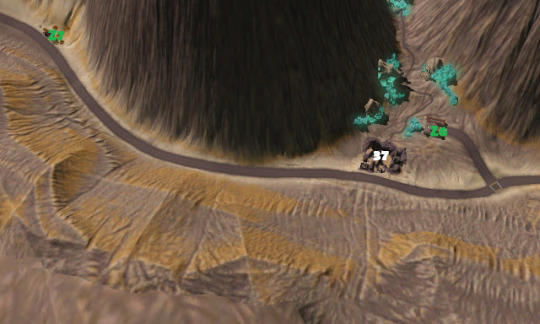
Image: The Crystal Mine, the Outpost, and the Depot
On the backside of the craters, we have the Crystal Mine, the Outpost, and the Depot. We're told in the original backstory blurb for the world on the Store page that the residents had to harness the crystals to to make their colony sustainable, but it feels abandoned now. Given the importance of the mine in the early days of the colony, it makes sense they'd have a transport depot here for the workers and an outpost, possibly for the military, to protect it, especially if the world was inhabited and the indigenous people wanted nothing to do with them or actively apposed them.
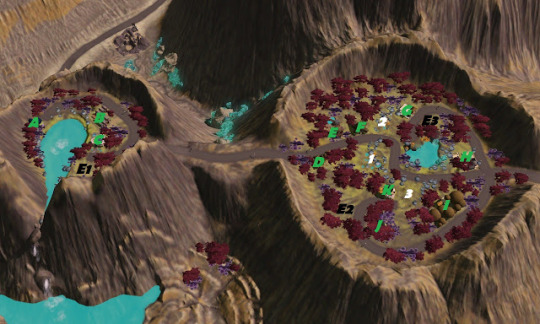
Image: The Craters from Lunar Lakes
Which brings us finally to the craters themselves. Here's where Zomia comes in. If Lunar Lakes was inhabited and if the native population had no interest in joining the colonists or being exploited by them, where would they go? The craters, of course! This would also hold true for anyone who didn't want to fall in line with the colonial leadership among the human sims themselves. We know the Louie family, for example, had to move to the craters after they were exiled by Patricia Cross, the current colonial leader. It therefore stands to reason that, even if the people who live here are colonists, this is where they are expected to go if they are exiled or want to get away from the political milieu of the central powers in the downtown district.

Image: Suburban Subspace lot from Lunar Lakes
And, of course, architecturally, this is where we got those distinctive mushroom houses, which again, suggests an alternative development of this region compared to the lowlands even if the people here are exiled colonists, deviants, etc.
Regardless, we end up with a setting that is rife for internal worldbuilding and storytelling based on its geography. If you add an alien population seeking to escape SimEarth colonization by fleeing to the craters, it establishes a political backdrop for stories, making the world feel more lived in and providing a ready-made backstory. This is one of the things I think is drastically missing in the Sims 4 with their itty-bitty neighborhoods and lack of connecting spaces.
Anyways, these are the things I think about when worldbuilding myself. What story does my world tell geographically? Does it have a built in backstory represented by its geography? Are the different regions/neighborhoods connected in a way that makes cohesive sense? Are their other worlds you think do a good job of storytelling with their designs?
If you build worlds, do you take into account the storytelling potential of your geography? Why or why not? If you play in worlds like Lunar Lakes, does the geography inform your storytelling? Does it help build a metadiscourse around your game? Are there other worlds that inspire your gameplay with their layouts?
Edited in response to @nornities excellent feedback.
1) This is not meant as an endorsement of all of Quinn's arguments; he's got a weird overpopulation theory built into his writing that's a little too close to Malthusian for my liking, but I'm not one to throw out the baby with the bathwater, as it were.
2) Ever notice how "modernization" and "development" are always fundamentally anchored in how Europe moved from feudalism to imperialism to democracy etc.? Yeah, that's the remnants of that "cultural evolution" model I'm talking about. "You're not successful until you look like us!" "Take these developmental loans from the World Bank or the IMF! We promise the strings attached are for your benefit too!" "What do you mean you want to skip industrialization and natural resource extraction and invest in your environment, happiness, and long-term sustainability? You'll never be like us that way! You're a failed state! Ignore the coup in the background we swear we had nothing to do with!"
3) This is the section that was edited after @nornities pointed out that it could be read to imply that non-agricultural societies don't have taxes, class warfare, epidemics, subjugation, slavery, conscription, etc. That was not the intention, although it is clearly stated in Scott's original work that he considers these and other negative societal effects to be the direct result of such "civilizing projects." It was not my intent to perpetuate that idea as these things do happen in non-agricultural societies, so I have changed the original wording. Thank you, @nornities
4) I also forgot to mention the clear exception to this: the Incan Empire. Unlike most empire models, the Inca engaged in a top-down society (literally) that was based in the mountains and expanded downward and outward over time. They were predated by two earlier Andean civilizations.
17 notes
·
View notes